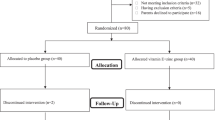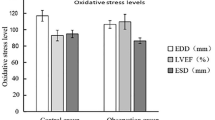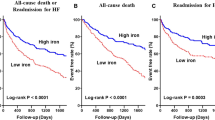Abstract
Background/objectives:
Post-operative atrial fibrillation (POAF) is a frequent complication of cardiac surgery. Oxidative stress and reduced antioxidant function have major roles in its development. Selenium is a key to normal antioxidant function, and levels are often low before cardiac surgery. This study investigated whether low preoperative selenium levels were associated with POAF in cardiac surgical patients.
Subjects/methods:
Using the Society of Thoracic Surgeons (STS) Mortality risk score, 50 patients having primary coronary artery bypass grafts (CABG) surgery were divided into two groups: (i) low-risk group (STS ⩽0.5%; n=26) and (ii) intermediate-risk group (STS ⩾2.0%; n=24). Plasma levels of selenium, glutathione peroxidase (GPx) and malondialdehyde (MDA) were measured in all patients at anaesthetic induction, after aortic cross-clamp removal, 3 h post cardiopulmonary bypass and on post-operative days 1 and 5. Multiple logistic regression was used to assess whether selenium levels were associated with POAF development.
Results:
Seventeen patients developed POAF (14 patients in the intermediate-risk group and 3 patients in the low-risk group). Preoperative selenium was lower in patients who developed POAF compared with those with normal sinus rhythm (0.73±0.16 vs 0.89±0.13 μmol/l, P=0.005), and this was independently associated with POAF (PR 0.32; 95% confidence credible interval (95%cI) 0.06–0.85, P=0.016). Regardless of POAF, preoperative selenium was lower in the intermediate-risk patients than in the low-risk patients (0.77±0.15 vs 0.89±0.14 μmol/l; P=0.004).
Conclusions:
Intermediate-risk patients with low preoperative selenium levels may be at a greater risk of developing POAF following CABG. This raises the question of whether selenium supplementation in select cardiac surgical patients may reduce their POAF risk.
This is a preview of subscription content, access via your institution
Access options
Subscribe to this journal
Receive 12 print issues and online access
$259.00 per year
only $21.58 per issue
Buy this article
- Purchase on Springer Link
- Instant access to full article PDF
Prices may be subject to local taxes which are calculated during checkout


Similar content being viewed by others
References
Echahidi N, Pibarot P, O'Hara G, Mathieu P . Mechanisms, prevention, and treatment of atrial fibrillation after cardiac surgery. J Am Coll Cardiol 2008; 51: 793–801.
Maesen B, Nijs J, Maessen J, Allessie M, Schotten U . Post-operative atrial fibrillation: a maze of mechanisms. Europace 2012; 14: 159–174.
Rho RW . The management of atrial fibrillation after cardiac surgery. Heart 2009; 95: 422–429.
Rostagno C, La Meir M, Gelsomino S, Ghilli L, Rossi A, Carone E et al. Atrial fibrillation after cardiac surgery: incidence, risk factors, and economic burden. J Cardiothorac Vasc Anesth 2010; 24: 952–958.
Korantzopoulos P, Kolettis T, Siogas K, Goudevenos J . Atrial fibrillation and electrical remodeling: the potential role of inflammation and oxidative stress. Med Sci Monit 2003; 9: RA225–RA229.
Korantzopoulos P, Kolettis TM, Galaris D, Goudevenos JA . The role of oxidative stress in the pathogenesis and perpetuation of atrial fibrillation. Int J Cardiol 2007; 115: 135–143.
Zakkar M, Ascione R, James AF, Angelini GD, Suleiman MS . Inflammation, oxidative stress and postoperative atrial fibrillation in cardiac surgery. Pharmacol Ther 2015; 154: 13–20.
Ali-Hassan-Sayegh S, Mirhosseini SJ, Rezaeisadrabadi M, Dehghan HR, Sedaghat-Hamedani F, Kayvanpour E et al. Antioxidant supplementations for prevention of atrial fibrillation after cardiac surgery: an updated comprehensive systematic review and meta-analysis of 23 randomized controlled trials. Interact Cardiovasc Thorac Surg 2014; 18: 646–654.
Vincent JL, Forceville X . Critically elucidating the role of selenium. Curr Opin Anaesthesiol 2008; 21: 148–154.
Thomson CD . Assessment of requirements for selenium and adequacy of selenium status: a review. Eur J Clin Nutr 2004; 58: 391–402.
Koszta G, Kacska Z, Szatmari K, Szerafin T, Fulesdi B . Lower whole blood selenium level is associated with higher operative risk and mortality following cardiac surgery. J Anesth 2012; 26: 812–821.
Landucci F, Mancinelli P, De Gaudio AR, Virgili G . Selenium supplementation in critically ill patients: a systematic review and meta-analysis. J Crit Care 2014; 29: 150–156.
Stoppe C, McDonald B, Rex S, Manzanares W, Whitlock R, Fremes S et al. SodiUm SeleniTe Adminstration IN Cardiac Surgery (SUSTAIN CSX-trial): study design of an international multicenter randomized double-blinded controlled trial of high dose sodium-selenite administration in high-risk cardiac surgical patients. Trials 2014; 15: 339.
Tinggi U . Essentiality and toxicity of selenium and its status in Australia: a review. Toxicol Lett 2003; 137: 103–110.
Stoppe C, Spillner J, Rossaint R, Coburn M, Schalte G, Wildenhues et al. Selenium blood concentrations in patients undergoing elective cardiac surgery and receiving perioperative sodium selenite administration. Nutrition 2013; 29: 158–165.
The Society of Thoracic Surgeons. Available from www.riskcalc.sts.org/stswebriskcalc/#/ (accessed 20 November 2015).
Deddens JA, Petersen MR . Approaches for estimating prevalence ratios. Occup Environ Med 2008; 65: 501–506.
Lunn DJ TA, Best N, Spiegelhalter D . WinBUGS - A Bayesian modelling framework: concepts, structure and extensibility. Stat Comput 2000; 10: 325–337.
Wu JH, Marchioli R, Silletta MG, Masson S, Sellke FW, Libby P et al. Oxidative stress biomarkers and incidence of postoperative atrial fibrillation in the Omega-3 Fatty Acids for Prevention of Postoperative Atrial Fibrillation (OPERA) Trial. J Am Heart Assoc 2015; 4: e001886.
Goodyear-Bruch C, Pierce JD . Oxidative stress in critically ill patients. Am J Crit Care 2002; 11: 543–551.
Arnaud J, Akbaraly TN, Hininger I, Roussel AM, Berr C . Factors associated with longitudinal plasma selenium decline in the elderly: the EVA study. J Nutr Biochem 2007; 18: 482–487.
Stevanovic A, Coburn M, Menon A, Rossaint R, Heyland D, Schalte G et al. The importance of intraoperative selenium blood levels on organ dysfunction in patients undergoing off-pump cardiac surgery: a randomised controlled trial. PLoS One 2014; 9: e104222.
Wu J, Xu GL . Plasma selenium content, platelet glutathione peroxidase and superoxide dismutase activity of residents in Kashin-Beck disease affected area in China. J Trace Elem Electrolytes Health Dis 1987; 1: 39–43.
Cui J, Zhong R, Chu E, Zhang XF, Zhang WG, Fang CF et al. Correlation between oxidative stress and L-type calcium channel expression in the ventricular myocardia of selenium-deficient mice. J Int Med Res 2012; 40: 1677–1687.
Negreva M, Georgiev S, Vitlianova K, Georgieva R . Selenium status in paroxysmal atrial fibrillation. Int J Med Pharm 2015; 3: 17–26.
Holzer R, Bockenkamp B, Booker P, Newland P, Ciotti G, Pozzi M . The impact of cardiopulmonary bypass on selenium status, thyroid function, and oxidative defense in children. Pediatr Cardiol 2004; 25: 522–528.
Huang Z, Rose AH, Hoffmann PR . The role of selenium in inflammation and immunity: from molecular mechanisms to therapeutic opportunities. Antioxid Redox Signal 2012; 16: 705–743.
Benstoem C, Goetzenich A, Kraemer S, Borosch S, Manzanares W, Hardy G et al. Selenium and its supplementation in cardiovascular disease-what do we know? Nutrients 2015; 7: 3094–3118.
Stoppe C, Spillner J, Rossaint R, Coburn M, Schalte G, Wildenhues et al. Selenium blood concentrations in patients undergoing elective cardiac surgery and receiving perioperative sodium selenite. Nutrition 2013; 29: 158–165.
Acknowledgements
JFF acknowledges support of OHMR medical research fellowship. This study was supported by a Queensland Health-Health Practitioner Research Grant Scheme (201213-037).
Author information
Authors and Affiliations
Corresponding author
Ethics declarations
Competing interests
The authors declare no conflict of interest.
Rights and permissions
About this article
Cite this article
McDonald, C., Fraser, J., Shekar, K. et al. Low preoperative selenium is associated with post-operative atrial fibrillation in patients having intermediate-risk coronary artery surgery. Eur J Clin Nutr 70, 1138–1143 (2016). https://doi.org/10.1038/ejcn.2016.125
Received:
Revised:
Accepted:
Published:
Issue Date:
DOI: https://doi.org/10.1038/ejcn.2016.125
This article is cited by
-
Trace Element Status and Postoperative Morbidity After On-pump Coronary Artery Bypass Surgery
Biological Trace Element Research (2023)
-
Micronutrient deficiencies and new-onset atrial fibrillation in a community-based cohort: data from PREVEND
Clinical Research in Cardiology (2023)
-
Comparison of Serum Selenium Levels Between Patients with Newly Diagnosed Atrial Fibrillation and Normal Controls
Biological Trace Element Research (2022)
-
Effects of Selenium Supplementation on Metabolic Status in Patients Undergoing for Coronary Artery Bypass Grafting (CABG) Surgery: a Randomized, Double-Blind, Placebo-Controlled Trial
Biological Trace Element Research (2019)



